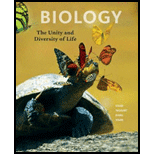
Concept explainers
An endoskeleton consists of _________.
- a. a fluid in an internal space
- b. hardened plat at the surface of a body
- c. internal hard parts
- d. a fluid that surrounds the body
Introduction: A skeletal system is essential for the body support and to protect the internal organs of the body. Our body movements are brought about by the muscles by its interaction with the skeleton. The skeletal system is mainly classified into three- hydrostatic skeleton, endoskeleton and exoskeleton.
Answer to Problem 1SQ
Correct answer: An endoskeleton consists of internal hard parts.
Hence, the correct answer is option c.
Explanation of Solution
Reason for the correct answer:
One of the main types of skeleton is the endoskeleton. Endoskeleton is a structural support found internally within an animal’s body. In humans, the endoskeleton is made up of framework of cartilages and bones. Another example- the sea stars are the echinoderms that contain the endoskeleton which is made up of hard, calcium-rich plates.
Option c. is given as “internal hard parts”.
An internal structural support found inside an animal made up of hard and tough mineralized tissue is termed as endoskeleton. Tissues present in the endoskeletons facilitate the movement by attaching to the muscles.
Hence, the correct answer is option c.
Reasons for the incorrect answers:
Option a. is given as “a fluid in an internal space”.
A fluid-filled internal space that obtains the energy for the contraction of muscles is known as hydrostatic skeleton. It does not contain the internal hard parts.
Hence, option a. is incorrect.
Option b. is given as “hardened plates at the surface of a body”.
This is incorrect because the structural support or the hardened plates that are found externally to support the outer surface of the body is called as exoskeleton. This is different from the endoskeleton.
Hence, option b. is incorrect.
Option d. is given as “a fluid that surrounds the body”.
This is incorrect because interstitial fluids or tissue fluids are the fluid that surrounds the body or are present between cell, blood vessels, and the lymph vessels. These fluids help to supply essential nutrients as well as removing the harmful substances from the spaces.
Hence, option d. is incorrect.
Hence the options a., b., and d. are incorrect.
Want to see more full solutions like this?
Chapter 35 Solutions
Biology: The Unity and Diversity of Life (MindTap Course List)
Additional Science Textbook Solutions
Biological Science (6th Edition)
EBK INTRODUCTION TO CHEMISTRY
Campbell Biology in Focus (2nd Edition)
Introductory Chemistry (6th Edition)
Living By Chemistry: First Edition Textbook
- 22. Which of the following mutant proteins is expected to have a dominant negative effect when over- expressed in normal cells? a. mutant PI3-kinase that lacks the SH2 domain but retains the kinase function b. mutant Grb2 protein that cannot bind to RTK c. mutant RTK that lacks the extracellular domain d. mutant PDK that has the PH domain but lost the kinase function e. all of the abovearrow_forwardWhat is the label ?arrow_forwardCan you described the image? Can you explain the question as well their answer and how to get to an answer to an problem like this?arrow_forward
- Describe the principle of homeostasis.arrow_forwardExplain how the hormones of the glands listed below travel around the body to target organs and tissues : Pituitary gland Hypothalamus Thyroid Parathyroid Adrenal Pineal Pancreas(islets of langerhans) Gonads (testes and ovaries) Placentaarrow_forwardWhat are the functions of the hormones produced in the glands listed below: Pituitary gland Hypothalamus Thyroid Parathyroid Adrenal Pineal Pancreas(islets of langerhans) Gonads (testes and ovaries) Placentaarrow_forward
 Medical Terminology for Health Professions, Spira...Health & NutritionISBN:9781305634350Author:Ann Ehrlich, Carol L. Schroeder, Laura Ehrlich, Katrina A. SchroederPublisher:Cengage Learning
Medical Terminology for Health Professions, Spira...Health & NutritionISBN:9781305634350Author:Ann Ehrlich, Carol L. Schroeder, Laura Ehrlich, Katrina A. SchroederPublisher:Cengage Learning Biology (MindTap Course List)BiologyISBN:9781337392938Author:Eldra Solomon, Charles Martin, Diana W. Martin, Linda R. BergPublisher:Cengage Learning
Biology (MindTap Course List)BiologyISBN:9781337392938Author:Eldra Solomon, Charles Martin, Diana W. Martin, Linda R. BergPublisher:Cengage Learning
 Human Physiology: From Cells to Systems (MindTap ...BiologyISBN:9781285866932Author:Lauralee SherwoodPublisher:Cengage Learning
Human Physiology: From Cells to Systems (MindTap ...BiologyISBN:9781285866932Author:Lauralee SherwoodPublisher:Cengage Learning Biology: The Dynamic Science (MindTap Course List)BiologyISBN:9781305389892Author:Peter J. Russell, Paul E. Hertz, Beverly McMillanPublisher:Cengage Learning
Biology: The Dynamic Science (MindTap Course List)BiologyISBN:9781305389892Author:Peter J. Russell, Paul E. Hertz, Beverly McMillanPublisher:Cengage Learning Biology: The Unity and Diversity of Life (MindTap...BiologyISBN:9781305073951Author:Cecie Starr, Ralph Taggart, Christine Evers, Lisa StarrPublisher:Cengage Learning
Biology: The Unity and Diversity of Life (MindTap...BiologyISBN:9781305073951Author:Cecie Starr, Ralph Taggart, Christine Evers, Lisa StarrPublisher:Cengage Learning





